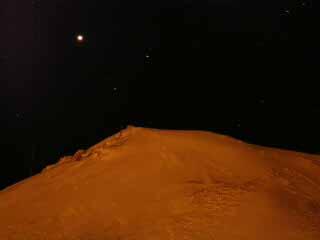27 August, 2003
Polar Caps and Mars
Tonight marks the closest approach of Mars for nearly 60,000 years. It will come within 35 million miles (56 million km). So I thought it fitting to take a picture of Mars rising over a peak of Ross Island. Even though Mars is closer now than ever in our life, you cannot see the white polar caps on Mars. The size of these caps change seasonally and they are made mostly of carbon dioxide cooled to its freezing point of -109 degrees F (-78.5 degrees C). It is interesting to me that if a Martian were looking toward the Earth and celebrating the closest approach of the Earth, then they would see Antarctica and the Arctic as Polar caps, their sizes changing with the seasons. However the polar cap that I am on is made of water. But, the coldest temperature ever recorded on Earth was at the Russian Vostok station in 1983 when they recorded a temperature of -129 degrees F. Go back and look at the temperature of dry ice (carbon dioxide) . . . . hmmm, I wonder what would happen if you exhaled at that temperature?
Today we successfully launched an ozone balloon. I spent the day calibrating and cleaning instruments. Tomorrow the winds look good for another try at the larger CN balloon.

Mars closeup showing the polar cap made of carbon dioxide (dry ice). Picture taken by NASA.

Mars over a peak on Ross Island, Antarctica.

Mars over a peak on Ross Island, Antarctica.
Contact the TEA in the field at
.
If you cannot connect through your browser, copy the
TEA's e-mail address in the "To:" line of
your favorite e-mail package.
|
